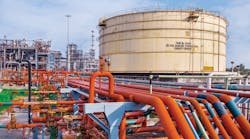Olefin content in FCC gasoline generally varies between 40-60 vol %. Residue feedstocks like atmospheric tower bottoms (ATB) and vacuum tower bottoms (VTB) raise olefin content, especially when the FCC operates with USY zeolite catalysts, high reaction temperatures, and short contact times.
Due to the shortage of other high-octane and olefin-free blending components like alkylate, isomerate, and oxygenates, many Chinese refineries find it difficult to meet stricter gasoline olefin limits of <35 vol % in China, or <20 vol % in other developed countries.
Olefins are the main contributors to octane in cracked gasoline. A reduced FCC gasoline olefin content creates some restrains including octane number and yield distribution. Each existing strategies for reducing FCC gasoline olefin has its strengths and weaknesses.
A non-paraffin base feed or hydrotreated feed produces less olefins. Operating FCC units with a higher catalyst-to-oil ratio, lower reaction temperature, greater catalyst make-up rate, or less feed also effectively reduces gasoline olefins.
There are, unfortunately, few adjustments a given refinery can make unless it sacrifices profits unnecessarily. Selectively hydrotreating FCC naphtha minimizes olefins and sulfur, but it may often lead to lost gasoline octane and higher processing costs.
Using new catalysts or additives can be a more effective solution. Several refiners have successfully implemented catalysts and additives into their olefin-reduction strategies.
Most new catalysts or additives are commercially proven to reduce naphtha olefins by about 10 vol % points, often with a little decline in gasoline research octane number (RON). This is, however, still inadequate to meet lower gasoline olefin specifications in some cases.
A second reactor allows the FCC naphtha to continue its secondary reactions to reduce olefin content.
Improving the FCC reactor design is the most economical and most efficient method for reducing olefins. Recycling the naphtha to the riser reactor prelifting zone is a simple and feasible reactor design.
Using the prelifting zone as an upgrading reactor allows full utilization of high-activity catalysts, but the reaction environment is too severe.
Recycling naphtha to another fluidized bed reactor connected directly to the riser outlet provides the naphtha an appropriate reaction environment with optimal reaction conditions.
Conversion and naphtha upgrading selectivity in this reactor design might be influenced because spent catalyst from the riser can catalyze the naphtha upgrading reaction.
Furthermore, both naphtha recycling cases result in interactions between heavy oil cracking and naphtha upgrading, either due to heavy oil cracking catalyzed by a coked catalyst with low activity or due to extra residence time of other riser-effluent fractions in the fluidized bed reactor.

